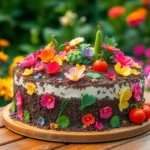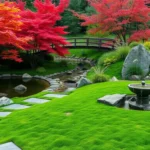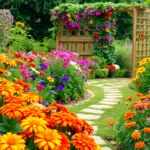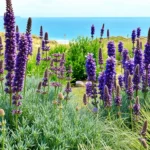Garden borders transform ordinary landscapes into stunning outdoor sanctuaries that captivate every visitor. We’ve discovered that the right border design doesn’t just define your garden spaces—it creates visual flow enhances curb appeal and adds incredible value to your property.
Whether you’re working with a sprawling backyard or a compact urban garden we know you want borders that complement your style while requiring minimal maintenance. From classic brick edging to modern metal strips and natural stone pathways the possibilities are endless.
The best part? Most border projects can be completed in a weekend with basic tools and materials you’ll find at any garden center. We’ll share proven techniques that professional landscapers use to create borders that look expensive but won’t break your budget. These strategic design choices will make your garden the envy of the neighborhood.
Classic Perennial Border Ideas for Garden Landscapes
Classic perennial borders remain the gold standard for creating enduring garden landscapes that deliver year after year beauty. We’ll explore proven combinations and techniques that professional landscapers use to achieve stunning results without the ongoing expense of annual replanting.
Herbaceous Perennial Combinations
Purple and white combinations create timeless elegance in any garden setting. We recommend pairing deep purple salvia with white peonies and silver artemisia for a sophisticated backdrop that blooms from late spring through early fall. Lavender adds fragrance while white roses provide vertical interest and extended flowering periods.
Warm color palettes featuring orange, red, and yellow perennials generate vibrant energy throughout the growing season. Combine orange daylilies with red bee balm and yellow coreopsis for a border that attracts butterflies and hummingbirds. Black eyed Susans extend the golden theme into late summer while red cardinal flower adds dramatic vertical spikes.
Cool color schemes using blues, purples, and whites offer a calming presence in garden landscapes. Plant blue delphinium behind white phlox with purple catmint as edging for a classic English garden effect. Campanula and white astilbe fill in gaps while maintaining the serene color story throughout multiple seasons.
Textural contrasts between fine and bold foliage create visual depth without relying solely on flower color. Pair feathery astilbe with broad hosta leaves and spiky iris foliage for ever-changing interplay. Ornamental grasses like fountain grass provide movement while sturdy perennials like bergenia offer structural foundation elements.
Seasonal Color Progression Planning
Spring emergence begins with early bulbs and emerging perennial foliage that sets the foundation for upcoming displays. We plan borders to showcase tulips and daffodils among emerging peony shoots and unfurling hosta leaves. Hellebores provide consistent blooms during transition periods when other perennials are still developing.
Summer peak season requires strategic plant placement to ensure continuous blooms from June through August. Stagger flowering times by combining early summer peonies with midsummer daylilies and late summer asters. Deadheading spent blooms on repeat flowering perennials like salvia and catmint extends their display well into fall.
Fall color transition maintains garden interest as growing seasons wind down through thoughtful plant selection. Ornamental grasses reach their prime display period while late blooming perennials like sedum and chrysanthemums take center stage. Perennials with attractive seed heads like echinacea provide winter interest and bird food sources.
Winter structure comes from perennials left standing to provide architectural elements during dormant months. Ornamental grasses, sturdy perennial stems, and evergreen perennials like bergenia maintain visual weight when deciduous plants retreat. Strategic placement of these structural elements prevents borders from appearing completely empty during winter months.
Height and Texture Layering Techniques
Back border positioning utilizes tall perennials to create vertical backdrops that anchor entire garden compositions. Plant delphinium, hollyhocks, and tall phlox against fences or walls where they won’t shade shorter plants. These vertical elements should comprise roughly 20% of total border plantings to maintain proper proportions.
Middle layer development features medium height perennials that bridge the gap between tall background plants and low edging materials. Daylilies, iris, and peonies work effectively at 24 to 36 inch heights while providing substantial flower displays. This middle zone typically occupies 50% of border space and carries the primary visual weight.
Foreground edging uses low growing perennials to create clean border definitions and provide close up viewing opportunities. Coral bells, catmint, and hardy geraniums form effective edges while offering extended blooming periods. These front plants should reach 12 to 18 inches maximum height to avoid obscuring taller specimens behind them.
Texture mixing combines fine, medium, and coarse textured plants to create visual richness beyond simple height arrangements. Feathery astilbe contrasts beautifully with bold hosta leaves and spiky iris foliage. Aim for 60% medium texture plants with 20% each of fine and coarse textures for balanced compositions that maintain interest throughout growing seasons.
Modern Minimalist Border Ideas for Garden Design

We’re embracing the clean lines and sophisticated simplicity that modern minimalist borders bring to contemporary garden spaces. These design approaches create stunning visual impact while maintaining the effortless elegance that defines minimalist landscaping.
Ornamental Grass Borders
Ornamental grasses transform garden borders with their natural movement and year-round texture. We love how these low maintenance plants create ever-changing borders that sway gracefully in the breeze. Feather reed grass, fountain grass, and blue fescue offer varying heights and textures that work beautifully in minimalist designs.
Seasonal interest becomes effortless with ornamental grass borders. These versatile plants provide structure during growing seasons and maintain their architectural beauty through winter months. Many varieties thrive in various soil conditions, making them perfect for gardeners seeking both beauty and practicality.
Grouping different grass varieties creates sophisticated layered effects. We recommend combining tall grasses like miscanthus with shorter options such as sedge to establish natural rhythm along border edges. This approach delivers professional results without requiring extensive maintenance or frequent replanting.
Geometric Plant Arrangements
Geometric plant arrangements bring modern architectural elements directly into garden border design. We’re seeing more homeowners embrace triangular, square, and circular planting patterns that create striking visual organization. These structured approaches work exceptionally well with minimalist garden philosophies.
Repetition of geometric shapes throughout borders creates cohesive design flow. Square groupings of identical plants alternate with triangular arrangements of contrasting varieties to establish rhythm and movement. This technique transforms ordinary flower beds into contemporary industry art pieces.
Clean lines become achievable through careful plant selection and strategic spacing. We recommend using plants with similar growth habits within each geometric section to maintain sharp, defined edges. Boxwood, lavender, and ornamental grasses work particularly well for creating and maintaining these structured arrangements.
Monochromatic Color Schemes
Monochromatic color schemes create sophisticated harmony in minimalist garden borders. We’re using varying shades of single colors to develop cohesive looks that feel both elegant and intentional. Purple borders featuring deep eggplant, soft lavender, and silvery purple foliage create stunning graduated effects.
Texture becomes the star when color palettes remain constrained. Different plant forms within the same color family add visual interest without creating chaotic color competition. Spiky purple alliums pair beautifully with rounded purple catmint and cascading purple petunias.
Seasonal progression maintains color consistency throughout growing seasons. We plan monochromatic borders by selecting plants that bloom at different times within the same color family. Early spring purple crocuses transition to summer purple salvia, followed by fall blooming purple asters for continuous seasonal beauty.
Cottage Garden Border Ideas for Garden Charm

Cottage garden borders bring timeless English countryside charm to our outdoor spaces through their delightfully informal and romantic appeal. We’ll explore how to create these enchanting borders that blend practicality with whimsical beauty.
Mixed Flower and Herb Combinations
Aromatic herbs paired with colorful blooms create the foundation of authentic cottage garden borders. We recommend combining Russian Sage, Yarrow, and Spirea with vibrant Black-Eyed Susans and Butterfly Bush for maximum visual impact. Lavender adds both fragrance and silvery texture while rosemary contributes evergreen structure throughout winter months.
Strategic plant placement ensures continuous interest from spring through fall. Plants like Campanula lactiflora ‘Loddon Anna’ provide stunning mid to late summer displays when earlier bloomers begin to fade. We suggest selecting varieties with staggered bloom times to maintain year-round color progression.
Herb integration serves both aesthetic and practical purposes in cottage borders. Culinary herbs like thyme and oregano create low-growing carpets between taller flowering plants. These fragrant additions attract beneficial pollinators while providing fresh ingredients for our kitchens.
Informal Planting Styles
Natural groupings without strict symmetry define the cottage garden aesthetic. We embrace relaxed plant arrangements that encourage organic growth patterns rather than formal geometric designs. This approach creates visual softness that feels inviting and lived-in.
Single, open flowers support local pollinator populations while maintaining authentic cottage charm. We prioritize varieties with accessible nectar sources over complex double blooms that offer little wildlife value. Native wildflowers mixed with traditional cottage plants create sustainable ecosystems.
Controlled chaos requires thoughtful planning even though its casual appearance. We recommend grouping plants in odd numbers and allowing some self-seeding annuals to naturalize throughout the border. This technique creates the appearance of spontaneous growth while maintaining overall garden health.
Vintage Garden Accessories Integration
Weathered garden accessories add historical character to cottage-style borders. We incorporate old wooden benches, vintage watering cans, and antique garden tools as decorative focal points. These elements create authentic period atmosphere that enhances the romantic cottage garden theme.
Stone pathways and rustic planters provide structure within informal plantings. We use reclaimed materials like old bricks or natural flagstone to create meandering paths through cottage borders. Terra cotta pots and wooden planters add vertical interest while maintaining the handcrafted aesthetic.
Repurposed household items become charming garden features in cottage settings. We transform old colanders into hanging planters and vintage baskets into container gardens. These creative additions reflect the cottage garden tradition of resourcefulness and sustainable gardening practices.
Edible Border Ideas for Garden Functionality

Transform your garden borders into productive spaces that deliver both visual appeal and fresh ingredients for your table. We’ll explore practical edible border strategies that maximize garden functionality while maintaining stunning aesthetics.
Herb and Vegetable Border Designs
Creating herb and vegetable borders requires thoughtful planning to achieve both beauty and productivity. Aromatic herbs like mint, basil, and rosemary serve as natural border plants while providing fragrant ingredients for cooking. Leafy greens such as kale and spinach create lush, verdant borders that change throughout the growing season.
Color coordination enhances the visual impact of edible borders significantly. Choosing a unified color scheme like chartreuse and purple creates cohesive design elements that tie the entire garden together. We recommend selecting vegetables and herbs that complement this palette for maximum aesthetic effect.
Pathway integration transforms edible borders into functional garden features. Using crushed gravel and benderboard defines clear walking paths while allowing easy access to harvest plants. This approach prevents soil compaction while maintaining neat, organized borders that look professionally designed.
Fruit Tree Understory Plantings
Understory plantings beneath fruit trees maximize garden space while improving overall network health. Companion herbs like mint and clover planted under fruit trees enhance soil fertility naturally while reducing common garden pests. These plants create living mulch that retains moisture and suppresses weeds effectively.
Shade tolerant options expand planting possibilities in areas with partial sunlight. Black raspberries and currants thrive in the dappled shade beneath fruit tree canopies, providing additional berry harvests. These plants complement the vertical structure of fruit trees while adding horizontal interest at ground level.
Biodiversity increases when we layer different plant types in understory areas. Multiple plant species create beneficial insect habitats while providing various harvest opportunities throughout the growing season.
Companion Planting Strategies
Strategic plant partnerships deliver multiple benefits beyond simple space efficiency. Pest deterrent combinations like marigolds paired with tomatoes naturally reduce nematode populations without chemical interventions. Basil planted alongside tomatoes improves fruit flavor while repelling harmful insects.
Growth habit compatibility ensures plants thrive together without competing for resources. Selecting plants with complementary root depths, light requirements, and nutrient needs maximizes garden productivity. Deep rooted plants paired with shallow rooted varieties use different soil layers effectively.
Mutual benefit systems create sustainable garden ecosystems that support long term health. Plants that fix nitrogen benefit neighboring heavy feeders, while aromatic herbs provide natural pest protection for vulnerable vegetables. These relationships reduce maintenance requirements while increasing overall harvest yields.
Low-Maintenance Border Ideas for Garden Simplicity

Creating stunning garden borders doesn’t require endless weekend maintenance sessions. We’ve discovered that strategic plant choices can deliver maximum visual impact while demanding minimal care from busy homeowners.
Drought-Tolerant Plant Selections
Lavender stands out as our top recommendation for low maintenance drought tolerant borders. This fragrant perennial thrives in poor soil conditions and produces beautiful purple spikes that bloom throughout summer. We love how lavender requires minimal watering once established and actually performs better when slightly neglected.
Lady’s Mantle offers excellent ground coverage with remarkable drought resistance. This versatile plant works beautifully under trees or along walkways where other plants struggle. We appreciate how its soft green foliage creates a lush appearance even during dry spells.
Daylilies provide attractive year round foliage that withstands challenging conditions. While individual flowers last only one day, the continuous bloom cycle ensures color throughout the growing season. We recommend planting multiple varieties to extend the flowering period from early summer through fall.
Native Plant Border Designs
Native grasses add natural texture and seasonal color while requiring minimal intervention. Species like Little Bluestem and Buffalo Grass create movement in the industry and provide winter interest. We’ve found that native grasses establish deep root systems that make them incredibly drought tolerant.
Wildflowers attract beneficial pollinators while bringing vibrant natural colors to garden spaces. Black Eyed Susans, Purple Coneflowers, and Bee Balm create stunning displays that support local ecosystems. We encourage mixing different bloom times to ensure continuous color from spring through late fall.
Native plant combinations enhance biodiversity while reducing long term maintenance needs. Local species naturally adapt to regional climate conditions and soil types. We recommend consulting your local extension office for exact native plant recommendations that thrive in your area.
Ground Cover Alternatives
Creeping Thyme fills gaps between pavers and tolerates light foot traffic beautifully. This aromatic groundcover releases pleasant fragrances when stepped on and produces tiny flowers in summer. We use creeping thyme along pathways where traditional lawn grass struggles to establish.
Creeping Juniper provides excellent evergreen coverage with minimal maintenance requirements. This spreading conifer works particularly well on slopes and areas where erosion control is needed. We appreciate how creeping juniper maintains its appearance year round without requiring pruning or fertilization.
Sedums create visually appealing borders when planted close to curbs and walkways. These succulent plants store water in their thick leaves, making them extremely drought tolerant. We recommend mixing different sedum varieties to create interesting textural contrasts and extended bloom periods.
Delosperma delivers vibrant colors that make ideal edging along garden paths. Also known as Ice Plant, these succulents produce brilliant daisy like flowers in orange, purple, and pink. We’ve found that Delosperma thrives in poor soil conditions where other plants fail to establish.
Seasonal Border Ideas for Garden Year-Round Interest

Creating borders that captivate throughout every season transforms your garden into a ever-changing masterpiece. We’ll show you how to design borders that maintain beauty and interest from spring’s first blooms through winter’s structural elements.
Spring Bulb Border Displays
Early flowering bulbs like crocuses, daffodils, and tulips create the foundation for spectacular spring displays. We recommend planting these bulbs in natural drifts rather than rigid rows to achieve a more organic appearance that mimics nature’s own patterns.
Complementary plants become essential partners for extending your border’s appeal beyond the bulb season. Early blooming perennials such as hellebores and pulmonaria provide structure while your bulbs emerge, creating layered interest that carries through late spring.
Structural elements remain crucial even as bulbs fade, so we suggest incorporating small shrubs or ornamental grasses that maintain visual weight. These permanent fixtures ensure your border doesn’t become bare patches once the bulb foliage dies back naturally.
Summer Annual Combinations
Colorful annuals transform borders into vibrant showcases during the peak growing season. Marigolds, zinnias, and petunias offer continuous blooms when planted in strategic combinations that consider height, spread, and flowering periods.
Foliage and texture additions prevent summer borders from appearing flat or one dimensional. We combine flowering annuals with dramatic foliage plants like coleus or caladium, plus ornamental grasses that add movement and subtle color variations.
Strategic placement maximizes visual impact while ensuring proper growing conditions for each plant type. Taller annuals work best at the back of borders, while spreading varieties fill gaps and cascade over edges for a polished appearance.
Fall Foliage and Berry Features
Foliage plants become the stars of autumn borders when selected for their spectacular color transformations. Maples, oaks, and ornamental shrubs like burning bush provide the dramatic reds, oranges, and yellows that define fall garden beauty.
Berry producing plants extend seasonal interest well into winter months while attracting beneficial wildlife. Holly, crabapples, and winterberry offer colorful fruits that persist after leaves drop, creating focal points against bare branches and evergreen backdrops.
Timing considerations help you orchestrate peak fall displays by understanding when different plants reach their color peaks. Early fall performers like sumac pair beautifully with late season stars such as oak trees for extended autumn interest.
Winter Structure and Evergreen Elements
Evergreen shrubs maintain essential structure when deciduous plants enter dormancy. Boxwood, holly, and yews provide the backbone that keeps borders looking intentional rather than abandoned during winter months.
Winter interest plants offer surprising beauty during the garden’s quietest season. Winter flowering heather, ornamental grasses with persistent seed heads, and plants with interesting bark textures create subtle but captivating displays.
Architectural elements become more prominent in winter borders, making plant placement and form more critical. We focus on creating strong silhouettes and varying heights that look attractive even when covered with snow or frost.
Shade Border Ideas for Garden Problem Areas

We transform challenging shaded garden areas into stunning focal points with strategic border designs that thrive in low light conditions. These specialized borders solve common gardening problems while creating beautiful displays that complement your overall industry design.
Hostas and Fern Combinations
Hostas provide the perfect foundation for shade border success with their diverse sizes and color variations ranging from deep green to variegated patterns. We recommend pairing large hostas like ‘Sum and Substance’ with delicate lady ferns to create dramatic scale contrasts that draw the eye naturally through the border.
Ferns add essential textural elements that complement hosta’s broad leaves while requiring minimal maintenance throughout the growing season. Royal ferns work exceptionally well behind medium sized hostas, creating layered depth that mimics natural woodland environments.
Combining different hosta varieties with various fern species creates year round interest even when flowering perennials fade. We suggest grouping three to five hostas of the same variety together, then weaving ferns throughout to establish natural looking drifts that feel organic rather than planted.
Flowering Shade Perennials
Bleeding hearts deliver spectacular heart shaped flowers that dangle gracefully from arching stems in spring, providing essential early season color before tree canopies fully develop. We plant these alongside hostas because their foliage remains attractive even after blooming ends.
Hellebores bloom remarkably early in the season, often pushing through snow to display their cup shaped flowers in shades of white, pink, and deep purple. These evergreen perennials maintain their glossy foliage throughout winter, ensuring your shade border never looks empty or forgotten.
Astilbe produces feathery plumes in vibrant colors including coral, white, and deep red that brighten shaded areas from late spring through early summer. We space these flowering perennials 18 inches apart to allow for their mature spread while creating substantial color impact.
Coral bells offer both attractive foliage and delicate flower spikes that emerge in late spring, extending the blooming season in your shade border. Their leaves come in colors ranging from lime green to deep burgundy, providing foliage interest even when not in bloom.
Foliage Color Contrasts
Light green foliage creates brilliant contrast when paired with darker specimens like Royal Purple Smoke Bush, establishing visual drama that makes shade borders feel intentional and sophisticated. We use this technique to prevent shade gardens from appearing monotonous or dull.
Japanese Sedge provides golden yellow grass like texture that illuminates darker corners while maintaining its color intensity throughout the growing season. This ornamental grass contrasts beautifully with broad leafed hostas and creates movement in still air.
Purple foliage plants like Heuchera ‘Palace Purple’ add rich color depth that prevents green dominated shade borders from feeling flat or uninteresting. We position these darker plants strategically to anchor lighter colored specimens and create focal points.
Variegated leaves from plants like Japanese Forest Grass bring light to shaded areas while turning attractive copper tones in winter for extended seasonal interest. These specimens work particularly well when planted near solid green companions to highlight their unique coloring patterns.
Fragrant Border Ideas for Garden Sensory Appeal

We’ll now explore how fragrant borders transform ordinary garden spaces into sensory havens that engage both sight and smell. Scented plantings positioned strategically near walkways and seating areas maximize our daily exposure to natural fragrances while creating year round visual interest.
Aromatic Herb Plantings
Evergreen herbs form the backbone of fragrant borders with their reliable scent and year round foliage appeal. Rosemary, sage, and bay provide robust aromatic foundations that withstand seasonal changes while serving both ornamental and culinary purposes. These hardy selections thrive in well-drained soil conditions and require minimal maintenance once established.
Ground covering thyme varieties excel between pavers and along border edges where foot traffic releases their fresh herbal aroma naturally. Walking or brushing against these low growing herbs creates instant fragrant moments that enhance our garden experience. Different thyme cultivars offer subtle scent variations from lemony to traditional herbal notes.
Curry plant (Helichrysum italicum) delivers bold yellow summer flowers alongside year round fragrance that intensifies near pathways and gathering spaces. This Mediterranean native maintains its aromatic qualities through all seasons while providing striking visual contrast with its silvery foliage. Positioning curry plants strategically ensures ongoing scent exposure during regular garden activities.
Scented Flower Combinations
Garden phlox creates fragrant summer clusters in vibrant colors while attracting beneficial pollinators to our borders. These perennial favorites offer excellent vase life when cut and provide concentrated fragrance in high traffic garden areas. Planting phlox in drifts amplifies both visual impact and aromatic intensity.
Lavender adds structural elements with its distinctive spiky form and soothing herbal fragrance that persists even when dried. This versatile perennial works exceptionally well as border edging or accent planting while requiring minimal water once established. Multiple lavender varieties extend blooming periods and create layered fragrance experiences.
Rose selections provide classic floral fragrance throughout summer months while contributing timeless beauty to mixed borders. Combining roses with complementary perennials creates ever-changing seasonal displays that maintain interest beyond peak blooming periods. Strategic rose placement near seating areas maximizes our enjoyment of their renowned fragrance.
Early spring Coronilla glauca offers sweet scented yellow flowers that herald the growing season with delicate fragrance and cheerful color. This reliable performer bridges the gap between winter dormancy and full summer bloom cycles. Incorporating early flowering plants ensures fragrant interest throughout extended growing seasons.
Evening Fragrance Gardens
Night scented plants release their strongest fragrances after sunset when cooler temperatures carry scents more effectively through garden spaces. Evening scented stock (Matthiola longipetala) and night blooming jasmine (Cestrum nocturnum) transform twilight hours into aromatic experiences. These specialized plants complement daytime fragrant varieties by extending sensory appeal into evening hours.
Strategic positioning near outdoor seating maximizes evening enjoyment of night fragrant plantings during cooler, more comfortable hours. Pathways leading to relaxation areas benefit from flanking night scented plants that guide visitors through fragrant corridors. Proper spacing prevents overcrowding while allowing individual plant fragrances to develop fully.
Grouping complementary fragrances creates harmonious effects rather than competing scent combinations that can become overwhelming. Avoiding clashing aromas requires careful selection and thoughtful placement of evening fragrant varieties. Testing plant combinations in small areas helps determine successful pairings before larger installations.
| Border Type | Key Plants | Season/Time | Sensory Benefit |
|---|---|---|---|
| Herb Plantings | Rosemary, Thyme, Bay | All year | Fresh, herbal, practical |
| Scented Flowers | Phlox, Lavender, Roses | Spring–Fall | Floral, pollinator-friendly |
| Evening Fragrance | Night-stock, Jasmine | Night | Intoxicating, relaxing |
Budget-Friendly Border Ideas for Garden Makeovers

Creating stunning garden borders doesn’t require very costly. These cost-effective methods help us maximize our garden potential while keeping expenses minimal.
DIY Propagation Techniques
Stem cuttings provide us with the most reliable method for multiplying our favorite border plants without purchasing new specimens. We remove 4-6 inch stems from mature plants like roses, hydrangeas, and lavender during their active growing season. After removing the lower leaves and dipping the cut end in rooting hormone, we plant these cuttings in moist potting soil and keep them in a bright location away from direct sunlight.
Leaf propagation works exceptionally well for succulents and begonias that can transform our border edges with minimal investment. We gently remove healthy leaves from parent plants and allow them to callus for 24-48 hours before placing them on well-draining soil. These leaves develop new root systems and eventually grow into independent plants that we can transplant throughout our borders.
Division techniques allow us to multiply perennial plants like hostas, daylilies, and ornamental grasses that already exist in our gardens. We dig up established clumps during their dormant season and carefully separate them into smaller sections, ensuring each division has both roots and shoots. This method gives us multiple plants from a single original specimen at no additional cost.
Seed Starting Strategies
Indoor starting gives us a head start on the growing season by beginning seeds 4-6 weeks before our region’s last frost date. We use recycled containers like yogurt cups or egg cartons as seed trays, drilling drainage holes in the bottom to prevent waterlogging. Starting seeds indoors costs significantly less than purchasing mature plants and allows us to grow varieties that might not be available locally.
Soil selection plays a crucial role in successful seed germination, so we invest in quality seed starting mix rather than using regular garden soil. Commercial seed starting mixes provide the right balance of drainage and moisture retention that young seedlings need. We can also create our own mix by combining equal parts peat moss, vermiculite, and perlite for optimal growing conditions.
Lighting requirements determine seedling success, so we provide 12-16 hours of bright light daily using affordable LED grow lights or fluorescent fixtures. We position lights 2-4 inches above seedlings and adjust the height as plants grow taller. Natural sunlight from south-facing windows can supplement artificial lighting during peak daylight hours.
Plant Division and Sharing
Division timing matters significantly for plant health and successful establishment, so we schedule these activities during each plant’s dormant season. Spring-blooming perennials like peonies and irises respond best to fall division, while fall-blooming varieties prefer spring division. We mark our calendars to divide plants every 3-5 years when they become overcrowded or show declining vigor.
Sharing networks expand our plant collections through community exchanges with neighbors, friends, and local gardening groups. We organize plant swaps where gardeners bring divisions of their established perennials to trade for new varieties. Social media groups and community bulletin boards help us connect with other gardeners interested in sharing their surplus plants.
Plant labeling ensures we remember what we’ve shared and received, so we create simple tags using popsicle sticks and permanent markers. We record the plant name, bloom time, and care requirements on each label before transplanting divisions. Taking photos of our trades helps us track which plants came from which sources and their performance in our exact growing conditions.
Conclusion
We’ve explored how garden borders can transform any outdoor space from ordinary to extraordinary. Whether you’re drawn to classic perennial displays sophisticated minimalist designs or charming cottage garden aesthetics there’s a border style that perfectly matches your vision and lifestyle.
The key to successful border gardening lies in understanding your space and choosing plants that work with your environment rather than against it. From drought-tolerant natives to fragrant evening gardens we’ve shown you how to create borders that deliver maximum impact with smart plant selection.
Remember that great garden borders don’t require massive budgets or professional installation. With the propagation techniques plant division strategies and seasonal planning tips we’ve shared you can build stunning borders that provide year-round beauty while staying within your means.
Start with one border idea that excites you most and watch how it transforms your entire garden experience.
Frequently Asked Questions
What are the main benefits of adding garden borders to my outdoor space?
Garden borders create visual flow, improve curb appeal, and increase property value. They help define spaces, organize your garden layout, and provide structure that enhances the overall aesthetic of your landscape. Well-designed borders can transform an ordinary yard into a polished, professional-looking outdoor space.
Can I complete a garden border project myself over a weekend?
Yes, most border projects can be completed over a weekend with basic tools. The key is proper planning and preparation. Start with smaller sections, have all materials ready beforehand, and choose plants that are easy to establish. Simple borders using perennials or ground covers are particularly beginner-friendly.
What’s the difference between classic perennial borders and modern minimalist designs?
Classic perennial borders feature layered plantings with varied heights, textures, and seasonal color progressions, creating lush, traditional appeal. Modern minimalist borders emphasize clean lines, geometric arrangements, ornamental grasses, and monochromatic color schemes for sophisticated simplicity and lower maintenance requirements.
How do I create a cottage garden border style?
Cottage garden borders combine aromatic herbs with colorful blooms in informal, natural groupings. Use plants like Russian Sage, Yarrow, and Black-Eyed Susans. Incorporate vintage accessories, weathered materials, and allow organic growth patterns. The key is creating a relaxed, romantic aesthetic that mimics English countryside charm.
Can garden borders be both beautiful and productive?
Absolutely! Edible borders combine herbs, vegetables, and fruit trees to create functional yet attractive spaces. Use colorful vegetables, aromatic herbs, and companion planting strategies. Integrate pathways for easy harvesting while maintaining visual appeal through thoughtful color coordination and strategic plant placement.
What are the best low-maintenance border options?
Choose drought-tolerant plants like lavender, Lady’s Mantle, and daylilies. Native plant borders require minimal care while supporting local biodiversity. Ground covers such as creeping thyme, creeping juniper, and sedums fill spaces naturally and need little maintenance once established.
How do I ensure year-round interest in my garden borders?
Plan for seasonal progression with spring bulbs, summer annuals, fall foliage plants, and winter structural elements. Include evergreens for consistent backbone, and select plants with different bloom times. Consider plants with interesting bark, seed heads, or berries for winter appeal.
What plants work best for shady border areas?
Combine hostas and ferns for varied textures and sizes. Add flowering shade perennials like bleeding hearts, hellebores, and astilbe for color. Use variegated plants and foliage with different colors to create contrast and visual interest in low-light conditions.
How can I create fragrant garden borders?
Use evergreen herbs like rosemary, sage, and bay for year-round scent. Plant ground-covering thyme varieties and fragrant flowers such as phlox, lavender, and roses. Consider evening fragrance gardens with night-scented plants for enhanced twilight garden experiences.
Is it possible to create beautiful borders on a tight budget?
Yes! Use DIY propagation techniques like stem cuttings and plant division to multiply existing plants. Start plants from seeds indoors using quality soil mixes. Participate in plant exchanges with local gardening communities to expand your collection without spending money on new plants.


![Landscape Edging 33FT,Garden Edging Borders [Extra Tall 4IN High] Flexible](https://m.media-amazon.com/images/I/41aPsdwWpmL._SL500_.jpg)











